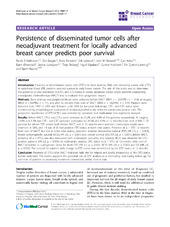| dc.description.abstract | Introduction: Presence of disseminated tumor cells (DTCs) in bone marrow (BM) and circulating tumor cells (CTC) in peripheral blood (PB) predicts reduced survival in early breast cancer. The aim of this study was to determine the presence of and alterations in DTC- and CTC-status in locally advanced breast cancer patients undergoing neoadjuvant chemotherapy (NACT) and to evaluate their prognostic impact. Methods: Bone marrow and peripheral blood were collected before NACT (BM1: n = 231/PB1: n = 219), at surgery (BM2: n = 69/PB2: n = 71), and after 12 months from start of NACT (BM3: n = 162/PB3: n = 141). Patients were included from 1997 to 2003 and followed until 2009 (or ten years follow-up). DTC- and CTC-status were determined by morphological evaluation of immunocytochemically detected cytokeratin-positive cells. The prognostic significance of DTCs/CTCs was assessed by univariate and multivariate Cox-regression analyses. Results: Before NACT, DTCs and CTCs were detected in 21.2% and 4.9% of the patients, respectively. At surgery, 15.9% and 1.4% had DTC- and CTC-presence, compared to 26.5% and 4.3% at 12 months from start of NACT. Of patients for whom DTC results both before NACT and at 12 months were available, concordant results were observed in 68%, and 14 out of 65 had positive DTC-status at both time points. Presence of ≥ 1 DTC 12 months from start of NACT, but not at other time points, predicted reduced disease-free survival (DFS; HR 2.3, p = 0.003), breast cancer-specific survival (BCSS; HR 3.0, p < 0.001) and overall survival (OS; HR 2.8, p < 0.001). Before NACT, presence of ≥ 3 DTCs was also associated with unfavorable outcome, and reduced BCSS was observed for CTCpositive patients (HR 2.2, p = 0.046). In multivariate analysis, DTC status (</≥ 1 DTC) at 12 months after start of NACT remained as a prognostic factor for both DFS (HR 2.2, p = 0.005), BCSS (HR 2.6, p = 0.002) and OS (HR 2.6,p = 0.002). The survival for patients with change in DTC-status was determined by the DTC-status at 12 months. Conclusion: Presence of DTCs after NACT indicated high risk for relapse and death, irrespective of the DTC-status before treatment. The results supports the potential use of DTC analysis as a monitoring tool during follow up, for selection of patients to secondary treatment intervention within clinical trials. | en_US |

